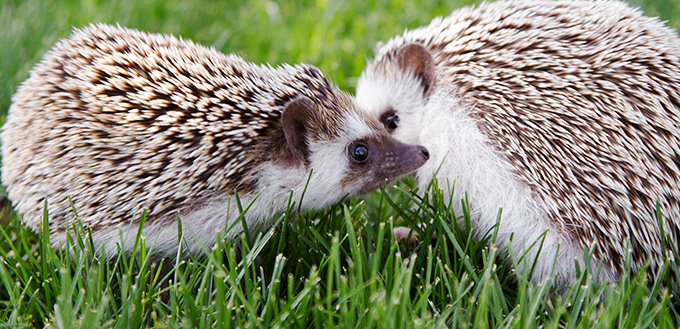During the summer months porcupines are most active at dawn and dusk, just when busy dog owners are most likely to be getting out with their beloved pets. The only way to ensure that your dog avoids a painful meeting with a porcupine is to keep him close and on a lead, but if your dog does become the victim of a porcupine encounter and ends up sporting a fine collection of spines, what should you do?
Porcupines Do Not Shoot Their Quills
There is an urban myth that porcupines are able to shoot their quills at attackers, but this is not so. Porcupine quills are released on contact.

Symptoms of Porcupine Quill Invasion
- Visible quills (particularly around the face and neck, in the mouth and anywhere over the body
- Trauma at the site where a quill has migrated into the body
- Drooling
- Head shaking
- Pawing at face or quill entry points
- Pain
- Lameness
Your dog is likely to be distressed at having things sticking out of him and porcupine quills have barbs on them that are specifically designed to migrate the quills deeper into the flesh as they are moved or pawed, so try to keep your dog as calm as possible.
Think very carefully about whether you want to try and remove the quills yourself as the trauma of having them removed without sedation could cause your dog to refuse to let you touch in him the future if he has any injuries or issues. Also, as it can be a fiddly and painful business to remove quills with sedation your dog may lash out and bite you.
DO NOT be tempted to cut the quills off (there is an urban myth that this deflates them and makes them easier to remove. In reality, this is going to make the quills harder to remove and easier to become embedded under the skin, as they will now be shorter.
Porcupine quills can migrate under the skin and into the body, puncturing major organs, causing eye loss and also infections or lameness in joints. Because of the nature of the barbs on porcupine quills, they are far more likely to work their way INTO the body than make their own way out, so careful removal at the earliest opportunity is essential.
Unless your dog only has a few quills embedded in his skin you should keep him calm and take him to a vet immediately.
If You Do Decide to Remove Porcupine Quills Yourself
- Have someone to help you by holding your dog
- Speaker to him slowly and calmly
- Use pliers
- You may want to distract your dog or hide his eyes so that he doesn’t see the pliers coming
- Grasp the base of the quill, as close to your dog’s skin as possible and pull out steadily to avoid breaking it
- Quills are tapered and come to a sharp point at the very end, so make sure you have ALL of the quill out
At the Vets
Make sure that you noted the time the incident took place if you have brought your dog straight to the vet, or mention that you have been in a place none to have a porcupine population if you are presenting some time afterwards, this will help the vet to get an idea of whether quills may have migrated into the body.
A vet will be able to sedate your dog before attempting to remove any porcupine quills which will ease the stress for your pet. Sedation will also allow for any surgery that might be required to remove migrated quills before they can cause any major issues.
Your vet will also be able to check your dog more easily for any migrated quills as his muscles and body will be relaxed.
There may be a prescription of antibiotics as well to try and ensure that no infection sets in.
The vert will do everything possible to remove all the quills, but some may prove impossible to get out and some that have already migrated into your dog could be missed, so you will need to monitor him carefully once you get him home.

Aftercare
A trip to the vets and removal of quills under sedation and some antibiotics should have cleared your dog of any on-going problems, but once at home you will need to keep an eye on him for several weeks afterwards and return to the vets as soon as you notice anything untoward with your pet, as migrated quills could have caused internal problems or entry wounds may have become infected.
Once Quilled and My Dog Will Learn?
It would seem that this isn’t the case and that even once they have been quilled and endured removal dogs do not avoid porcupines in the future, so if you want to avoid a repeat of this painful experience for your dog, you should avoid areas known for porcupine dens as much as possible, or at the very least avoid visiting these areas at dawn and dusk when they are at their most active.
Source:
- Dr. Malcolm Weir, Porcupine Quills in Dogs and Their Dangers, VCA







